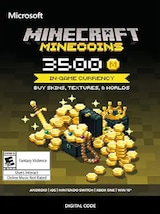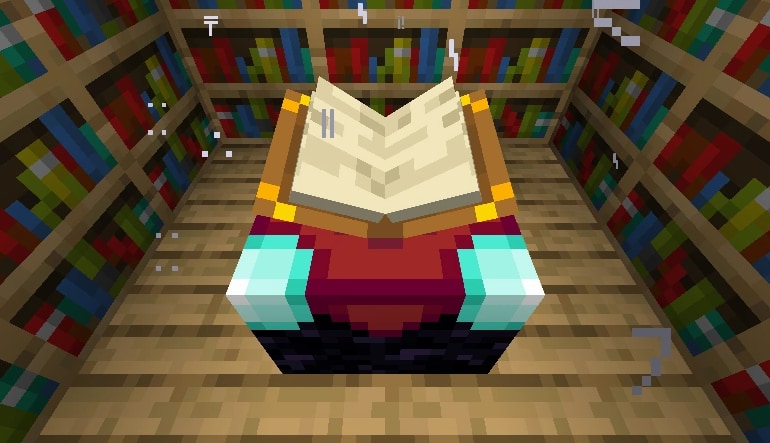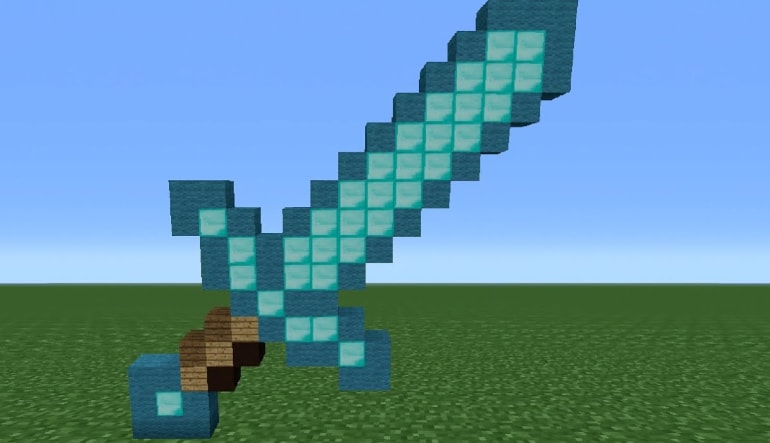Minecraft is an open-world sandbox game with a virtually endless, voxel-based world. There is no clear goal in the game other than setting your own goals that will be often related to either exploration, combat, or building.
You can let your creativity run wild in Minecraft and build whatever you want, using the blocks that make the game world. Mine resources, shape the surroundings to your liking, and make your dream creations come true.
To become a capable adventurer in Minecraft, you’ll need to learn how to use enchantments to your advantage. Today we’ll be explaining everything you need to know when it comes to enchanting swords. Which sword enchantments are the best? Which ones can be skipped? Which ones can be useful in certain situations? That’s what we’ll be focusing on.
Minecraft – What Are Enchantments?
Enchantments are powerful bonuses that can be applied to equipment items, namely: armor, tools, and weapons. Books can be enchanted as well, serving as a storage for enchantments. You can make such books yourself or you can sometimes find them in the open world, for example, in treasure chests, via fishing, or by trading with villagers. Books can be merged on the anvil. Merging books with the same enchantment of different levels will result in creating a book with a higher-level enchantment.
Enchantments are very useful as they can make you stronger in combat or more efficient at exploring and building. Some enchantments can directly improve your damage, others can help you find more loot, and others can positively affect an enchanted item’s durability.
An enchanted item will receive a special glint animation to make it easily distinguishable from other, non-enchanted items.
How to Enchant a Sword in Minecraft?
To enchant a sword or any other item in Minecraft, you will need an enchanting table, which is created by combining 4 pieces of obsidian, 2 diamonds, and a book. When you access the table and place an item you wish to enchant inside, a set of 3 random enchantments will be generated and you will be able to choose one. To reroll available enchantments, you will have to enchant something – just throw in some other item, preferably a low-tier junk, such as a wooden sword.
The tier of available enchantments will vary and depends on the number of nearby bookshelves; the table should be surrounded by at least 15 bookshelf blocks to allow for generating the highest-tier enchantments.
Enchanting an item will cost you a certain number of lapis lazuli and character levels.
All swords can be enchanted. It doesn’t matter if it’s the most basic wooden sword, a mighty diamond sword, or even a netherite sword; they can all be enchanted. However, more often than not, saving enchants for the highest-tier sword that is available to you makes the most sense, as enchantments are quite rare and expensive, especially if you’re hunting for the best ones. It’s only natural to save them for your best gear to make the most out of your limited resources.
How Many Enchantments Can a Sword Have?
In theory, there is no limit to the number of enchantments you can have on your sword, but with each newly added one, the cost of adding more increases drastically, which means that if you want to put all possible enchantments on your sword, you’ll have to use very specific strategies. This involves combining enchantment books on anvil to create books that contain multiple enchantments.
Sharpness (V), Smite (V), and Bane of Arthropods (V)
Let’s start with three special sword enchantments. Sharpness, Smite, and Bane of Arthropods are unique in that your sword can only benefit from one of them at any given time. These enchantments are mutually exclusive and are all directly related to the amount of damage dealt by the enchanted weapon. If your primary goal is to make the most powerful sword in Minecraft, picking one enchantment of your choice from this group is essential. This is, in fact, the only way to increase the baseline power of your weapon through enchantments.
The weakest enchantment here is the Bane of Arthropods and by a large margin. This enchantment causes the weapon to deal 2.5 extra damage per enchantment level to targets such as spiders and bees. The thing is, Bane of Arthropods targets relatively easy creatures, so getting more damage specifically against them is an overkill, especially considering that you’ll spend most of your time fighting more powerful enemies, rendering this particular enchantment virtually useless.
Thus, the real debate is about Sharpness vs Smite.
Smite adds 2.5 extra damage per enchantment level to all undead enemies. This includes all variations of zombies and skeletons, as well as strays, husks, phantoms, drowned, and zoglins. Considering how common undead enemies are in Minecraft, Smite will come in handy in most combat scenarios. Notable enemies that are not affected by Smite include creepers and endermen.
On the other hand, Sharpness serves as a general buff and increases damage dealt to any entity in the game. As a balancing measure, Sharpness provides significantly less damage bonus than Smite. In Java Edition, it adds 0.5 damage per enchantment level, plus an extra 0.5. In Bedrock Edition, it adds 1.25 extra damage per level.
Sharpness, due to the fact that it works against all enemies, makes it a viable choice if you want your weapon to be more versatile or you’re playing to play PvP. Smite would be a better choice if you’re willing to sacrifice the extra damage against non-undead enemies from Sharpness in favor of dealing more damage to the undead ones.
A popular solution to this dilemma is to carry two different weapons with different enchantments: an axe with Smite and a sword with Sharpness.
Mending (I)
Mending is an extremely valuable enchantment that basically removes the need to craft new items unless you lose it. An item with Mending enchantment will restore its durability as you gain experience. Every time you receive an experience orb, some of that experience will be used to repair equipped items that have Mending.
Mending doesn’t directly make you more powerful or more efficient at your tasks, but it makes your life much more convenient, as you don’t have to worry about crafting or repairing your items anymore. You will be able to keep your other enchantments forever, potentially saving you a lot of time.
Mending is a treasure enchantment and can only be found in the open world or obtained via trading with villagers. As such, due to its rarity, it may be smart to save it until you have a very high-tier, end-game weapon.
Looting (III)
In Minecraft, looting plays a major role in gameplay. You’ll often find yourself farming certain resources. Having a weapon with Looting enchantment will significantly speed things up. It does not only increase the maximum number of items for common drops by 1 per enchantment level but also increases the chances of obtaining rare resources from killed enemies.
For Looting to take effect, the item with Looting enchantment needs to be held at the moment of the enemy receiving a killing blow. This means that even though Looting is incredibly useful, you don’t necessarily have to put it on your main weapon if you can’t afford it. This approach, however, requires good reflexes and isn’t particularly convenient to play, as it requires you to constantly switch between two weapons: one without Looting to deal damage, and the other one with Looting to deal the final hit.
It’s also possible to shoot an arrow and switch to a Looting sword before the arrow reaches its target; if you do it right, the enemy will be affected by your Looting sword, even though it got killed by an arrow.
Sweeping Edge (III, Java Edition Only)
If you’re looking for ways to squeeze some extra damage out of your sword, Sweeping Edge is an obvious choice, as it increases damage done by the sweep attack and works against all enemies. At enchantment level I it deals extra damage equal to 50% of the sword’s attack damage and increases to 75% at level III when performing sweep attacks.
It’s particularly useful against groups of enemies, which you’ll find irreplaceable once you start creating your own mob farms with large numbers of creatures.
The caveat is that to make use of the enchantment, you have to actually use sweep attacks, which can be annoying in certain situations. You may, for example, accidentally hit your dog or other friendly creatures.
Fire Aspect (II)
Fire Aspect is the other must-have enchantment if you’re focusing on making a weapon that’s meant to kill enemies quickly, but it comes with a caveat. Fire Aspect doesn’t directly add any bonus damage to a weapon but instead, it allows it to set enemies on fire, making it especially useful against more sturdy enemies or swift enemies that are difficult to hit consistently, although you’d probably want to use a Fire Aspect bow against the latter. The caveat is that if a burning enemy touches you, you’ll start to burn too.
The longer the fight goes, the more useful Fire Aspect becomes, as the fire keeps dealing damage over time even if you’re not hitting the enemy after it starts to burn. Enemies that are hit by a Fire Aspect weapon receive 3 or 7 damage per second at enchantment levels I and II, respectively.
A cool side effect of a Fire Aspect weapon is that enemies that normally would drop raw meat, will now drop cooked meat instead. A Fire Aspect weapon can also be used to ignite TNT and light candles and campfires.
Certain enemies are immune to fire, which includes most of the Nether-exclusive mobs.
Even though Fire Aspect is incredibly powerful, there are situations where having this enchantment may be undesirable. This includes hunting endermen; when they are burning, they teleport a lot and if they happen to die from fire while they’re away from you, you may have trouble locating the loot. They can also set you on fire very easily if you let them touch you.
Unbreaking (III)
Unbreaking does what it says; items enchanted with Unbreaking will last you much longer, as they receive a chance to prevent durability loss when using the item. With Unbreaking I, items will last twice as long on average. With Unbreaking III, they’ll last 4 times longer than a non-enchanted counterpart.
While it may sound good, decreasing durability loss doesn’t prevent items from eventually getting destroyed; it just delays inevitable. As such, Unbreaking’s usefulness drops when you can enchant your items with Mending, which is far superior, as it will make the item last forever.
Ultimately, it would be great to have both, as they stack nicely with each other, but if you had to choose one, Mending is a clear winner, especially if you have an experience farm.
Don’t hesitate to use Unbreaking on newly acquired diamond and netherite tools though, it’s a solid enchantment to start with and will save you a lot of time; a diamond pickaxe with Unbreaking III will have roughly 6248 uses as opposed to 1562 without the enchantment.
Knockback (II)
Knockback is a self-explanatory enchantment that simply adds a bit of a knockback effect to your weapon. The enemy will be pushed away further with a higher enchantment level.
Knockback is a mixed bag when it comes to sword enchantments; some people love it, and some people hate it. It’s a good defensive enchantment that gives you more breathing room, especially when a group of enemies is charging at you. It can also be useful against creepers or sturdy enemies in 1 on 1 scenarios.
On the other hand, having to move forward a few extra steps to chase the enemy as it keeps being knocked back can be annoying, especially if it’s a ranged creature that keeps shooting back at you.
If you’re unsure about Knockback, there are probably other enchantments that will serve you much better.
Curse of Vanishing (I)
Curse of Vanishing is a special kind of enchantment, as it doesn’t directly benefit the wearer of the enchanted item. Similarly to Mending, Curse of Vanishing can’t be found in the enchanting table; it’s a treasure enchantment that can only be found in the open world or from trading with villagers.
Under normal circumstances, when you die, you will drop your equipment on the ground and you’ll get a chance to retrieve it unless your items find their way into a pool of lava, in which case they will be lost forever.
In a sense, Curse of Vanishing acts like lava – the enchantment causes the enchanted item to disappear when you die. As such, it seems to be absolutely pointless to use it when playing in a PvE mode, unless you want to give yourself an extra layer of difficulty for whatever reason.
Realistically speaking, Curse of Vanishing may be only useful in PvP if you don’t want the enemy to steal your gear.
How to Get a Sword with All Enchantments?
Following a few simple steps, you will be able to create the ultimate sword that has all 7 possible enchantments, minus the Curse of Vanishing, eliminating the dilemma of which sword enchantments in Minecraft are the best.
To do so, you will need a sword you want to enchant, an anvil, 7 enchanted books, each with a different enchantment (Fire Aspect, Unbreaking, Mending, Sharpness/Smite/Bane of Arthropods, Sweeping Edge, Looting, Knockback), and 55 levels. The books need to be at their original level and not previously combined; arguably, the best source of such enchanted books is the librarian villagers.
Here’s the procedure:
- Combine a Looting book with a Knockback book; you can do so on the anvil
- Combine a Sweeping Edge book with a Mending book
- Combine a Sharpness/Smite/Bane of Arthropods book with an Unbreaking book
- Combine the book created in 3. with a Fire Aspect book
- Combine your sword with the book created in 1.,2., and 4., in that order
And that’s it, your sword should have all 7 possible enchantments on it now.
Conclusion
In Minecraft, you can become more powerful by enchanting your equipment. You can enchant your armor, tools, and weapons, to deal more damage, spawn more loot, or make your items last longer. Utilizing enchantments is a must if you want to enjoy the game to the fullest, and so we made this guide to help you out a bit. This time we focused entirely on sword enchantments – hopefully now you understand the importance of enchantments and you’ll be able to choose the enchantments that are most beneficial to you.














